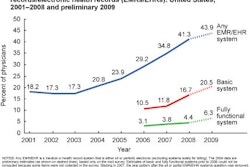Nearly 75% of office-based physicians used an electronic medical or health record (EMR/EHR) system during 2012, according to the U.S. National Center for Health Statistics (NCHS), part of the Centers for Disease Control and Prevention. Almost 40% of these physicians have installed a basic system at their practice.
This represents a steady increase in the use of EMR/EHR systems, up from 42% in 2008. The 2012 National Ambulatory Medical Care Survey results showed a spike in use from 57% in 2011 to 71.8% in 2012. This correlated with the federal "meaningful use" initiative of the U.S. Department of Health and Human Services.
Statistics on the adoption of basic systems in the office-based environment were not as dramatic. Usage has steadily risen from 10.5% in 2006, when physicians were first surveyed, to 39.6% in 2012. The increase between 2011 and 2012 was only 5.7%.
NCHS defined a basic system as one that enables users to acquire a patient's history and demographics, medical record, and list of medications and allergies. Such a system should also allow users to enter clinical notes and generate problem lists, as well as have electronic prescribing functionality and view laboratory and diagnostic imaging results.
This year, NCHS surveyed a sample of 10,302 physicians in all 50 states. The survey had a 67% response rate, according to the report's lead author, Chun-Ju Hsiao, PhD.
Approximately two-thirds of the respondents said they intend to participate in the meaningful use incentive program. However, only about 27% had acquired and were using computerized systems with capabilities to support 13 of the stage 1 core set objectives for meaningful use.
EMR/EHR system adoption varied by state. In Massachusetts, 89% of respondents said they used EMRs/EHRs, while New Jersey had the lowest percentage, at 54%. In addition, 71% of respondents from Wisconsin said they met the criteria for a basic system, compared with only 22% in Washington, DC, which had the lowest percentage.
Click here to read the entire report.



















